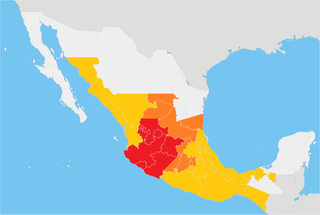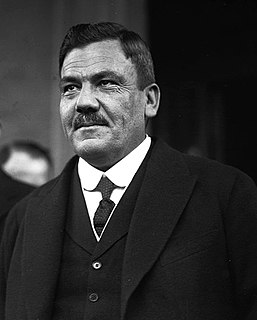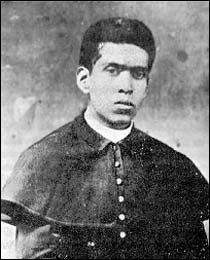 W
WThe Cristero War, also known as the Cristero Rebellion or La Cristiada [la kɾisˈtjaða], was a widespread struggle in central and western Mexico in response to the imposition of secularist and anticlerical articles of the 1917 Constitution of Mexico, which were perceived by opponents as anti-Catholic measures aimed at imposing state atheism. The rebellion was instigated as a response to an executive decree by Mexican President Plutarco Elías Calles to enforce Articles 3, 5, 24, 27, and 130 of the Constitution, a move known as the Calles Law. Calles sought to eliminate the power of the Catholic Church and all organizations which were affiliated with it and to suppress popular religious celebrations in local communities.
 W
WThe Battle of Tepatitlán was fought on April 19, 1929 at Tepatitlán in the state of Jalisco between the Cristeros and the army of the Mexican government. The government army was composed of 500 soldiers and 4,000 militia. The Cristeros were victorious but their leader Father Jose Reyes Vega was killed.
 W
WPlutarco Elías Calles was a Mexican military general and politician. He was the powerful interior minister under President Álvaro Obregón, who chose Calles as his successor. The 1924 Calles presidential campaign was the first populist presidential campaign in Mexico's history, as he called for land redistribution and promised equal justice, more education, additional labour rights, and democratic governance.
 W
WThe Constitution of Mexico, formally the Political Constitution of the United Mexican States, is the current constitution of Mexico. It was drafted in Santiago de Querétaro, in the State of Querétaro, by a constituent convention, during the Mexican Revolution. It was approved by the Constituent Congress on 5 February 1917. It is the successor to the Constitution of 1857, and earlier Mexican constitutions.
 W
WOn May 21, 2000, Pope John Paul II canonized a group of 25 saints and martyrs who had died in the Mexican Cristero War. The vast majority are Catholic priests who were executed for carrying out their ministry despite the suppression under the anti-clerical laws of Plutarco Elías Calles after the revolution in the 1920s. Priests who took up arms, however, were excluded from the process. The group of saints share the feast day of May 21.
 W
WDavid Galván Bermúdez was a Mexican Catholic priest who was killed during the Cristero War. He was canonized by Pope John Paul II on 21 May 2000 as one of 25 Martyrs of the Cristero War.
 W
WEnrique Gorostieta Velarde was a Mexican soldier best known for his leadership as a general during the Cristero War.
 W
WRafael Guízar y Valencia was a Mexican Catholic bishop who was active during the Mexican Revolution. Named Bishop of Xalapa in 1919, he was driven out of his diocese and forced to live the remainder of his life in hiding in Mexico City.
 W
WCristóbal Magallanes Jara, also known as Christopher Magallanes, is a priest and martyr of the Catholic Church who was killed without trial on the way to say Mass during the Cristero War after the trumped-up charge of inciting rebellion.
 W
WThe military history of Mexico encompasses armed conflicts within what that nation's territory, dating from before the arrival of Europeans in 1519 to the present era. Mexican military history is replete with small-scale revolts, foreign invasions, civil wars, indigenous uprisings, and coups d’etat by disgruntled military leaders. Mexico's colonial-era military was not established until the eighteenth century. After the Spanish conquest of central Mexico in the early sixteenth century, the Spanish crown did not rely on a standing military, but the crown responded to the external threat of a British invasion by establishing a standing military for the first time following the Seven Years' War (1756–63). The regular army units and militias had a short history when in the early 19th century, the unstable situation in Spain with the Napoleonic invasion gave rise to an insurgency for independence, propelled by militarily untrained, darker complected masses fight for the independence of Mexico. The Mexican War of Independence (1810–21) saw royalist and insurgent armies battling to a stalemate in 1820. That stalemate ended with the royalist military officer turned insurgent, Agustín de Iturbide persuading the guerrilla leader of the insurgency, Vicente Guerrero, to join in a unified movement for independence, forming the Army of the Three Guarantees. The royalist military had to decide whether to support newly independent Mexico. With the collapse of the Spanish state and the establishment of first a monarchy under Iturbide and then a republic, the state was a weak institution. The Roman Catholic Church and the military weathered independence better. Military men dominated Mexico's nineteenth-century history, most particularly General Antonio López de Santa Anna, under whom the Mexican military were defeated by Texas insurgents for independence in 1836 and then the U.S. invasion of Mexico (1846–48). With the overthrow of Santa Anna in 1855 and the installation of a government of political liberals, Mexico briefly had civilian heads of state. The Liberal Reforms that were instituted by Benito Juárez sought to curtail the power of the military and the church and wrote a new constitution in 1857 enshrining these principles. Conservatives comprised large land owners, the Church, and most of the regular army revolted against the Liberals, fighting a civil war. The Conservative military lost on the battlefield. But Conservatives sought another solution, supporting the French intervention in Mexico (1862–65). The Mexican army loyal to the liberal republic were unable to stop the French army's invasion, briefly halting it in with a victory at Puebla on 5 May 1862. Mexican Conservatives supported the installation of Maximilian Hapsburg as Emperor of Mexico, propped up by the French and Mexican armies. With the military aid of the U.S. flowing to the republican government in exile of Juárez, the French withdrew its military supporting othe monarchy and Maximilian was caught and executed. The Mexican army that emerged in the wake of the French Intervention was young and battle tested, not part of the military tradition dating to the colonial and early independence eras.
 W
WManuel Moralez was a Mexican layman who was killed during the Cristero War. A pro-Catholic activist during the anticlerical period under President Plutarco Elías Calles, he was captured by government forces, and was executed for refusing to renounce his position. Moralez was canonized by Pope John Paul II on 21 May 2000 as one of 25 Saints of the Cristero War.
 W
WDwight Whitney Morrow was an American businessman, diplomat, and politician of Scots-Irish descent, best known as the U.S. ambassador who improved U.S.-Mexican relations, mediating the religious conflict in Mexico known as the Cristero rebellion (1926–29), but also contributing to an easing of conflict between the two countries over oil. The Morrow Mission to Mexico was an "important step in the 'retreat from imperialism'". He was the father of Anne Morrow and father-in-law of Charles A. Lindbergh.
 W
WNational League for the Defense of Religious Liberty or National League for the Defense of Religious Freedom was a Mexican Catholic religious civil rights organization formed in March 1925 that played a crucial role in the Cristero War of 1926–1929. The Mexico City-based organization was created by former members of the short-lived National Catholic Party, the Union of Mexican Catholic Ladies ; a student organization, the Jesuit-led Catholic Association of Mexican Youth ; the Knights of Columbus; the National Parents' Association; and the National Catholic Labor Confederation. The League had by June of its founding year about 36,000 members and chapters in almost every state of the country. The organization arose after the anti-clerical provisions of the 1917 Mexican Constitution were strictly enforced by the fiercely anti-Catholic President Plutarco Calles and after he enacted further draconian provisions in the Calles Law.
 W
WJosé Ramón Miguel Agustín Pro Juárez, also known as Blessed Miguel Pro, was a Mexican Jesuit Catholic priest executed under the presidency of Plutarco Elías Calles on charges of bombing and attempted assassination of former Mexican President Álvaro Obregón.
 W
WVictoriano Ramírez López, also known as "El Catorce", was a Mexican General of the Cristero War known for his excellent combat skills.
 W
WDavid Roldán Lara was a Mexican layman who was killed during the Cristero War. A pro-Catholic activist during the anticlerical period under President Plutarco Elías Calles, he was captured by government forces, and was executed for refusing to renounce his position. Roldán was canonized by Pope John Paul II on 21 May 2000 as one of 25 Martyrs of the Cristero War.
 W
WToribio Romo González, known as Saint Toribio Romo was a Mexican Catholic priest and martyr who was killed during the anti-clerical persecutions of the Cristero War. Beatified and later canonized by Pope John Paul II along with 24 other saints and martyrs of the Cristero War, he is popularly venerated in Mexico and among Mexican immigrants, particularly for his reported miraculous appearances to migrants seeking to cross the Mexico–United States border. Also Related To a Small Texan Mexican now residing in Rochester NY.
 W
WSaint José Luis Sánchez del Río was a Mexican Cristero who was put to death by government officials because he refused to renounce his Catholic faith. His death was seen as a largely political venture on the part of government officials in their attempt to stamp out dissent and crush religious freedom in the area. He was dubbed "Joselito."